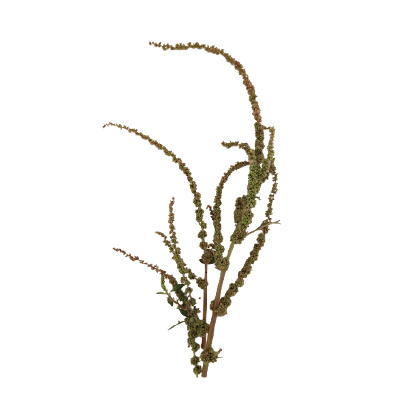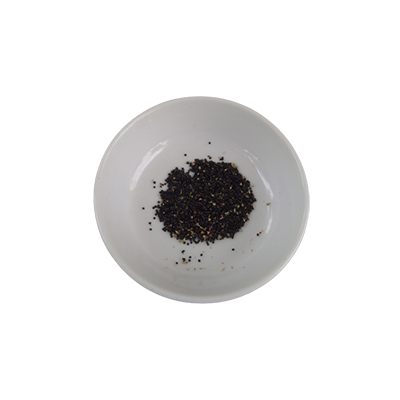Spiny Amaranth
Amaranthus spinosus L.
Amaranthaceae
Location in our garden
Beneficial Weed
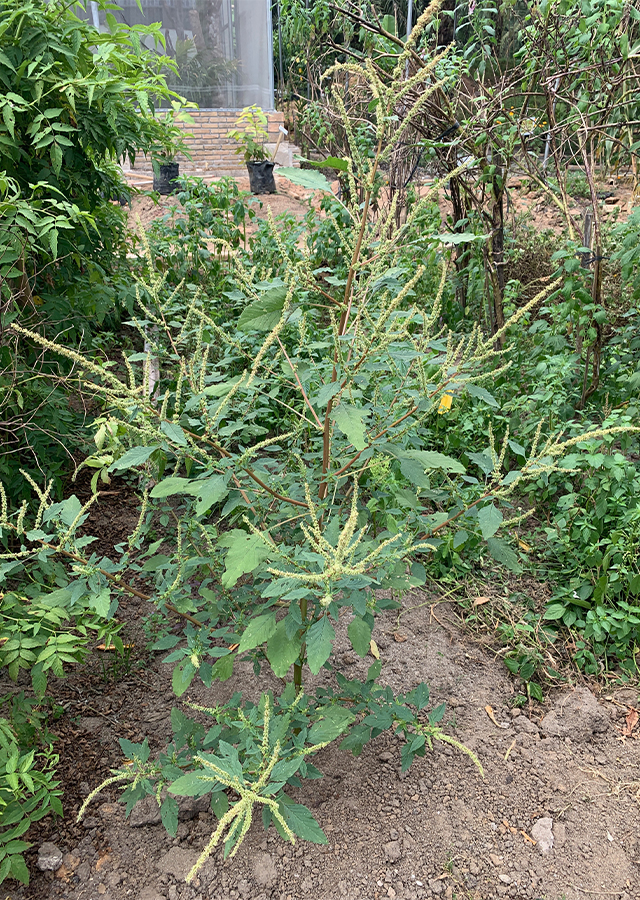
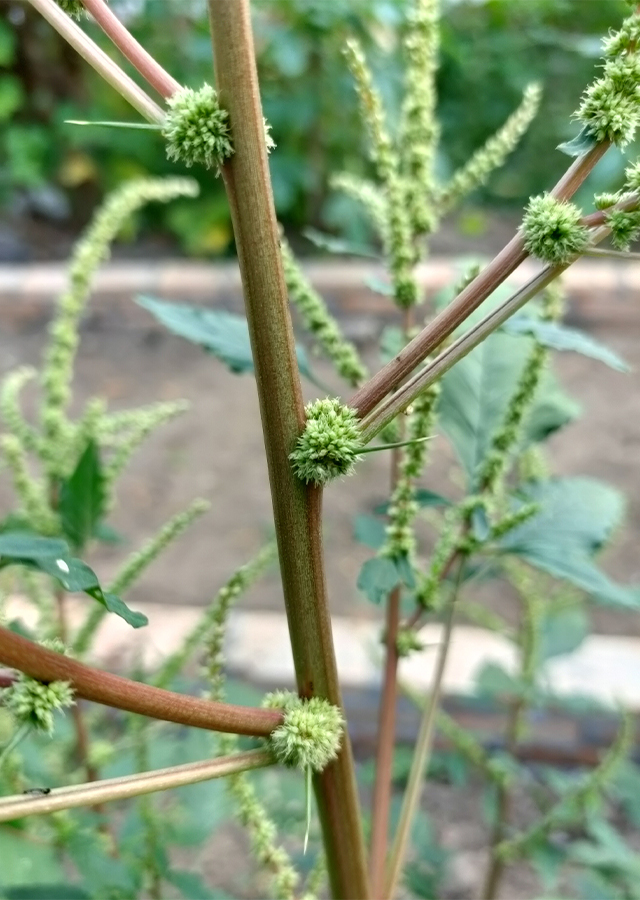
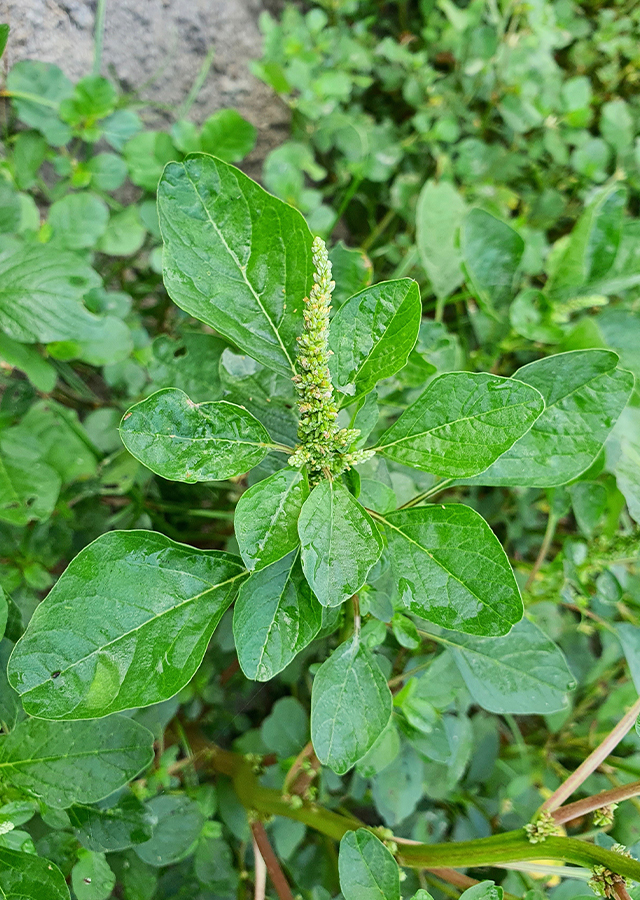
Synonym
Amaranthus caracasanus Kunth
Amaranthus coracanus Mart.
Amaranthus diacanthus Raf.
Habitus
Herbaceous. An erect, monoecious herb, up to 100 - 130 cm tall
Part Used
The Whole Plant
Growing Requirements
Full Sunshine
Drought Resistant
Habitat
Riverbanks
Forest
Roadside
Grassland
Overview
Spiny amaranth is believed to originate from lowland tropical South and Central America and was introduced into other warmer parts of the world. It often occurs as an invasive weed and is rarely cultivated. This weed has a wide distribution including the United States of America, and all tropical and subtropical regions of Africa and South-East Asia. Spiny amaranth, also known as hogweed, spiny pigweed, spiny carelessweed, or stickerweed, is an erect summer annual that is a member of the pigweed family (Amaranthaceae).
Vernacular Names
Hin-nu-new-subauk (Myanmar), Amarante épineuse (French), Amaranto (Portugese), Mchicha (Swahili), Phak Khom Nam (Thai), Ci xian (Chinese), Dorniger Fuchsschwanz (German), Bledo Espinoso (Spanish), Bayam duri (Indonesian), Uray, Orai (Tagalog).
Agroecology
A. spinosus is found in cultivated fields, waste places, roadsides, garbage heaps and abandoned fields. It will grow both in wet or dry sites, but grows best when soil moisture levels are below field capacity. Waterlogging retards its growth. Maximum growth is obtained on soils that are high in organic matter, loamy in texture and that have sufficient nitrogen. Thorn spinach grows well in places that are enough sunlight with air temperature between 25 - 35 °C.
Morphology
- Roots - taproot. Fibrous that come from a tap root that are sometimes red.
- Stems - terete or obtusely angular, glabrous or slightly pubescent, green or variably suffused with purple.Nodes that can be as long as a quarter of an inch.
- Leaves - glabrous, long-petioled, oblong to oblong ovate, or elliptic-lanceolate, 4 to 10 cm long, obtuse, alternate. Leaves are simple and can be 1 to 2 1/2 inches in length and 1/2 to 2 1/2 inches wide.
- Flowers - very numerous, stalkless, green or greening-white, about 1 mm long, and borne in dense, axillary clusters and in elongated terminal axillary spikes. Sepals are 5 or 1-3, ovate to linear, often aristate. Flower spike in terminal (predominately male) and numerous axillary clusters, chiefly female.
- Fruit - utricles, wrinkled, nearly as long as the sepals.
- Seeds - minute, black and shining.
Cultivation
Propagated by seeds.
Chemical Constituents
Anthraquinone, cardiac glycosides, saponins, flavonoids (diglikosida quercetin 3-0-rutinoside, kaemferol), phenols ( caffeoylquinic acid), betacyanin (amaranthine, isoamaranthine), isobetanin, betanin, alkaloid, hidrocxycinamat, amino acid, tannins, terpenoids. Other chemical compounds spinasterol, hentriakontan, potassium nitrate, calcium oxalate, phosphate salts, iron, and vitamins (A, C, K and pyridoxine (B6), b-sitosterol, stigmasterol, linoleic acid, routine and carotenoids.
Traditional Medicinal Uses
- Leaves, roots, and whole plant are used as a laxative, blood purifier, diuretic, and soporific.
- Studies have suggested antiprotozoal, anti-inflammatory, antioxidant, antimalarial, analgesic, antinociceptive activities.
- In the Philippines, decoction of roots has been used for treatment of gonorrhea.
- In the traditional medicine of Taiwan and China, it is used for diabetes.
- In the Gold Coast, enema prepared from the plant is used for piles.
- In China, poultice of seeds is used for broken bones; used internally for bleeding, diarrhea and menorrhagia.
- In Malaya, root decoction is used as diuretic.
- In Nigeria, ashes from burnt plant is used for sores; juice from plant is used as eye wash.
- Bruised leaves is used as emollient; applied externally to ulcerations in the mouth, eczema, burns, wounds, boils, earaches and hemorrhoids.
The benefits of spinach include: improve kidney function, strengthens hair roots and improve digestion.
Part Used
Reference Sources
- GBIF. (2019). Amaranthus spinosus L. https://www.gbif.org/species/5384401. 28-02-2021.
- CABI. (No date). Invasive Species Compendium. Amaranthus spinosus (spiny amaranth). https://www.cabi.org/isc/datasheet/4653#tosummaryOfInvasiveness 28-02-2021.
- Globinmed. (No date). Amaranthus spinosus. https://www.globinmed.com/index.php?option=com_content&view=article&id=79369:amaranthus-spinosus&Itemid=139. 28-02-2021.
- Stuartxchange. (2018). Philippine Medicinal Plants. Uray. http://www.stuartxchange.org/Uray.html 28-02-2021.
- Pl@nt Use. Amaranthus spinosus (PROSEA). https://uses.plantnet-project.org/en/Amaranthus_spinosus_(PROSEA) 28-02-20211.
- Ponggele ES, Jayanti KD. 2015. Pertumbuhan dan hasil tanaman bayam (Amaranthus spinosus L) pada berbagai jenis media tanam. Jurnal AgroPet 12(2): 1 – 6.
- Simanjuntak 2019. Uji aktivitas antibakteri ekstrak etanol daun bayam duri (Amaranthus spinosus L.) terhadap Staphylococcus aureus dan Escherichia coli secara in vitro. Skripsi Program studi Sarjana Farmasi Fakultas Farmasi Universitas Sumatera Utara. 73 hal
- Huff S, Rhodes Jr GN. Pasture Weed Fact Sheet Spiny Amaranth. Departement of Plant Sciences. Urextension Institute of Agriculture. The University of Tennessee. 2 p
- Mohamad E. 2013. Pengaruh Variasi Waktu Kontak Tanaman Bayam Duri terhadap Adsorpsi Logam Berat Kadmium (Cd). JURNAL ENTROPI, VIII (1): 562–571. Inovasi Penelitian, Pendidikan dan Pembelajaran Sains. 26 November 2021.
- Kuswaningrum O, Suwandono a, Ariyanti I, Hadisaputro S, Suhartono. 2017. The impact of consuming Amaranthus spinosus L. extract on prolactin level and breast milk production in postpartum mothers. Belitung Nursing Journal, 3 (5): 541–547. 26 November 2021.



